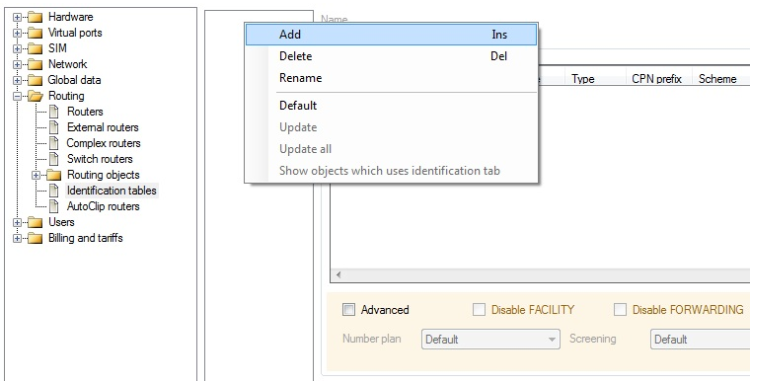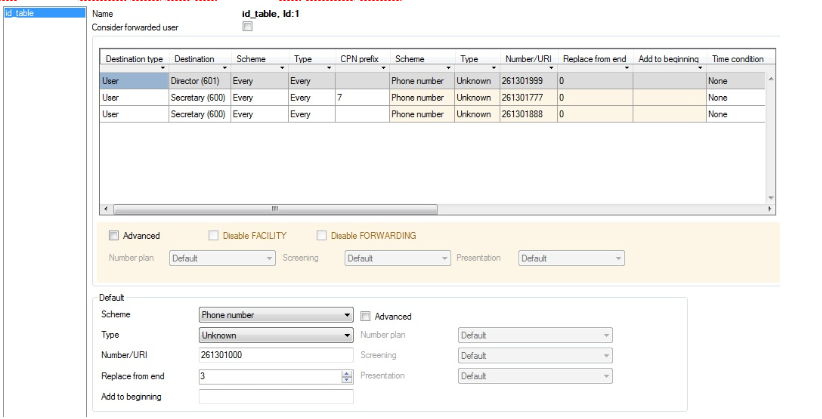ID Tables - How to set it in 2N® NetStar
Identification tables
The identification tables are used for changing the calling party number. To create and modify them go to section "Routing -> Identification tables". The setup menu consists of two main windows – Default setting window and Exceptions window.
Default setting window
Parameters in this window help us to set identification parameters for all calling parties that have not been found in the Exceptions window.
Scheme - define whether the calling party identifies itself by a Phone number, URI or it uses the previous identification after passing through this row.
Type - define the calling party number type before identification change. Choose one of the Unknown, Internal, Local, National, International and Preserve options. Use Unknown if you are not sure which type of number is used. Use Type only if the Scheme parameter is set to Phone number.
Number/URI – specifying the number which will be used as a calling party identification.
Replace from end - specifying the count of digits from number specified in Number/URI parameter which will be replaced by original internal number. If the original internal number is not transmitted, the resultant number will be same as set in the Number/URI parameter.
Add to beginning - use this parameter to add specific digits to the beginning of the new number.
Exceptions window
In exception window you can specify objects (users, virtual ports, etc.), for which different settings than the default one will be used.
Parameters in this window can be divided to three main groups
Calling party determination
- it contains the first five column where is specified the calling object for which is the exception valid.
- Destination type - in this column select a type of the calling party. Choose Any, Extension, Group, Type of extension, User, Virtual port or Virtual port type.
- Destination - use this column to define a calling party of the selected type (ex. user).
- Scheme - use this column to specify if the calling party identification should be presented as a Phone number, URI or Every (not specified).
- Type - use this column to define the calling party number subtype before identification changing. Choose one of the Unknown, Internal, Local, National, International and Every options. Use Every if you are not sure which type of number is used. You can use Type parameter only if the Scheme parameter is set to Phone number.
- CPN prefix (CPN – called party number) – by this parameter you can set that the same user (station, etc.) will identify itself differently depending on the called number. If you set this parameter to 420, this row will be valid only if the called number will be 420xxxxxx.
New calling party identification
- it contains next five columns (six to ten). Set completely new calling party identification.
- Scheme - define whether the calling party identify itself by a Phone number, URI or use the previous identification after passing through this row.
- Type - define the calling party number type before identification change. Choose one of the Unknown, Internal, Local, National, International and Preserve options. Use Unknown if you are not sure which number type is used. Use Type only if the Scheme parameter is set to Phone number.
- Number/URI - specifying the number which will be used as a calling party identification.
Time conditions
- specify time intervals during which are the exception rules valid.
Example
NetStar is connected to the PSTN via PRI line. All outgoing calls routed via this line must identify themselves as 261301xxx where xxx is an internal number of each user. The only exceptions are users "Director (600)" and "Secretary (601)". "Director (600)" will always identify himself by number 261301999 and "Secretary (601)" according to called number by numbers 261301777 (called prefix 7) and 261301888 (other called prefixes).
- Open the NetStar administrator and go to menu Routing -> Identification tables. Here click the right mouse button and add new id table.
- In new id table erase the default parameters and set them according to picture below. By this settings you specify that all calls which are not in exception table will identify themselves by number 261301000 where last three zeros will be replaced by user´s internal number.
- When default setting is done, move to the exceptions table and insert one record for user "Director (601)" and two records for user "Secretary (600)". For director set parameter Number/URI to 261301999 which will secure us that the director will always identify himself by this number. In first record for secretary set parameter CPN prefix to 7 and Number/URI to 261301777. By this setting we specify that if secretary makes an outgoing call to number starting with prefix 7, she will identify herself by number 261301777. If she makes a call to number with any other prefix, she will be identified by number 261301888 (second record).
- If you set everything properly, your id table should look like the table in the picture below.
- If your setting corresponds with previous picture, you created id table successfully. Last thing you have to do for proper calling party identification change is to assign this table to PRI line. Go to "Virtual ports -> BRI/PRI", choose correct PRI port and in Identification table parameter choose previously created id table.








